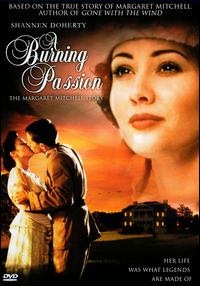
Gone with the Wind is a novel by American writer Margaret Mitchell, first published in 1936. The story is set in Clayton County and Atlanta, both in Georgia, during the American Civil War and Reconstruction Era. It depicts the struggles of young Scarlett O'Hara, the spoiled daughter of a well-to-do plantation owner, who must use every means at her disposal to claw her way out of poverty following Sherman's destructive "March to the Sea." This historical novel features a coming-of-age story, with the title taken from the poem "Non Sum Qualis eram Bonae Sub Regno Cynarae", written by Ernest Dowson.
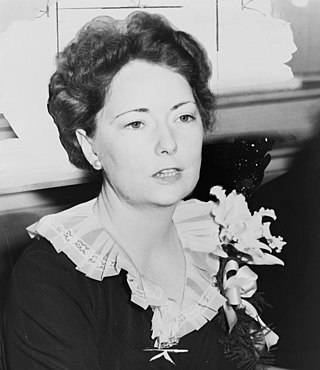
Margaret Munnerlyn Mitchell was an American novelist and journalist. Mitchell wrote only one novel that was published during her lifetime, the American Civil War-era novel Gone with the Wind, for which she won the National Book Award for Fiction for Most Distinguished Novel of 1936 and the Pulitzer Prize for Fiction in 1937. Long after her death, a collection of Mitchell's girlhood writings and a novella she wrote as a teenager, titled Lost Laysen, were published. A collection of newspaper articles written by Mitchell for The Atlanta Journal was republished in book form.

Katie Scarlett O'Hara is a fictional character and the protagonist in Margaret Mitchell's 1936 novel Gone with the Wind and in the 1939 film of the same name, where she is portrayed by Vivien Leigh. She also is the main character in the 1970 musical Scarlett and the 1991 book Scarlett, a sequel to Gone with the Wind that was written by Alexandra Ripley and adapted for a television mini-series in 1994. During early drafts of the original novel, Mitchell referred to her heroine as "Pansy", and did not decide on the name "Scarlett" until just before the novel went to print. PBS has called O'Hara "quite possibly the most famous female character in American history..."

Rhett Butler is a fictional character in the 1936 novel Gone with the Wind by Margaret Mitchell and in the 1939 film adaptation of the same name. It is one of Clark Gable's most recognizable and significant roles.

Melanie Hamilton is a fictional character first appearing in the 1936 novel Gone with the Wind by Margaret Mitchell. In the 1939 film she was portrayed by Olivia de Havilland. Melanie is Scarlett O'Hara's sister-in-law and eventually her best friend. Mitchell likely based the character on her cousin Sister Mary Melanie Holliday.
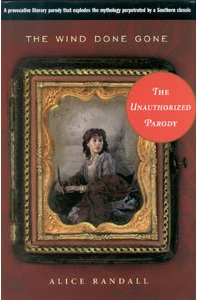
The Wind Done Gone (2001) is the first novel written by Alice Randall. It is a historical novel that tells an alternative account of the story in the American novel Gone with the Wind (1936) by Margaret Mitchell. While the story of Gone with the Wind focuses on the life of the daughter of a wealthy slave owner, Scarlett O'Hara, The Wind Done Gone tells the story of the life of slaves, Cynara, an enslaved woman during the same time period and events.

Mary Alicia Rhett was an American actress and portrait painter who is best remembered for her role as India Wilkes in the 1939 epic film Gone with the Wind. At the time of her death, Rhett was one of the oldest surviving credited cast members of the movie.
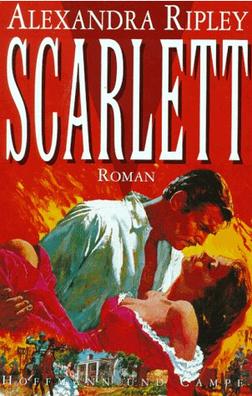
Scarlett is a 1991 novel by Alexandra Ripley, written as a sequel to Margaret Mitchell's 1936 novel, Gone with the Wind. The book debuted on TheNew York Times Best Seller list.
Tara is the name of a fictional plantation in the state of Georgia, in the historical novel Gone with the Wind (1936) by Margaret Mitchell. In the story, Tara is located 5 miles (8 km) from Jonesboro, in Clayton County, on the east side of the Flint River about 20 miles (32 km) south of Atlanta.
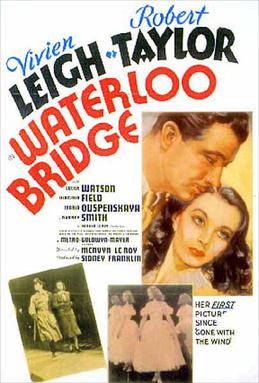
Waterloo Bridge is a 1940 American drama film and the remake of the 1931 film also called Waterloo Bridge, adapted from the 1930 play Waterloo Bridge. In an extended flashback narration, it recounts the story of a dancer and an army captain who meet by chance on Waterloo Bridge in London. The film was made by Metro-Goldwyn-Mayer, directed by Mervyn LeRoy and produced by Sidney Franklin and Mervyn LeRoy. The screenplay is by S. N. Behrman, Hans Rameau and George Froeschel, based on the Broadway drama by Robert E. Sherwood. The music is by Herbert Stothart and cinematography by Joseph Ruttenberg.
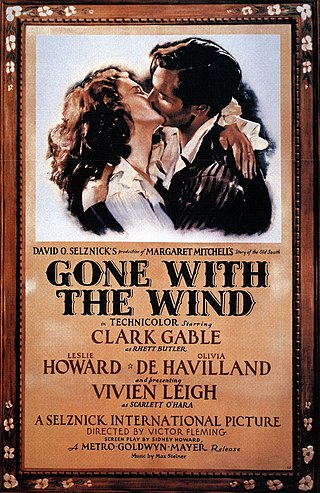
Gone with the Wind is a 1939 American epic historical romance film adapted from the 1936 novel by Margaret Mitchell. The film was produced by David O. Selznick of Selznick International Pictures and directed by Victor Fleming. Set in the American South against the backdrop of the American Civil War and the Reconstruction era, the film tells the story of Scarlett O'Hara, the strong-willed daughter of a Georgia plantation owner, following her romantic pursuit of Ashley Wilkes, who is married to his cousin, Melanie Hamilton, and her subsequent marriage to Rhett Butler.
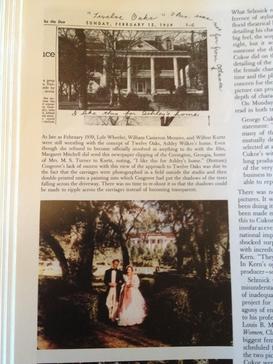
In Margaret Mitchell's 1936 novel Gone with the Wind, Twelve Oaks is the plantation home of the Wilkes family in Clayton County, Georgia named for the twelve great oak trees that surround the family mansion in an almost perfect circle. Twelve Oaks was described as a "beautiful white-columned house that crowned the hill like a Greek Temple," having true southern charm and whimsy. Margaret Mitchell came up with the idea for The Twelve Oaks, and modeled the home after an actual antebellum mansion located in the historic area of Covington, Georgia. The home that was portrayed as Margaret Mitchell's Twelve Oaks in the 1939 film has been renovated and is now open as a bed and breakfast and event facility in Covington, thirty minutes east of Atlanta.
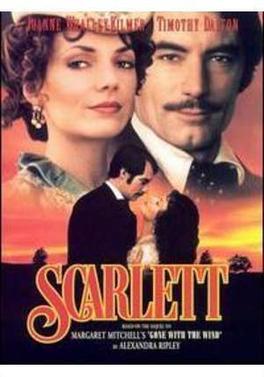
Scarlett is a 1994 American six-hour television miniseries loosely based on the 1991 book of the same name written by Alexandra Ripley as a sequel to Margaret Mitchell's 1936 novel Gone with the Wind. The series was filmed at 53 locations in the United States and abroad, and stars Joanne Whalley-Kilmer as Scarlett O'Hara, Timothy Dalton as Rhett Butler, and Sean Bean as Lord Richard Fenton. The miniseries was broadcast in four parts on CBS on November 13, 15, 16, and 17, 1994.
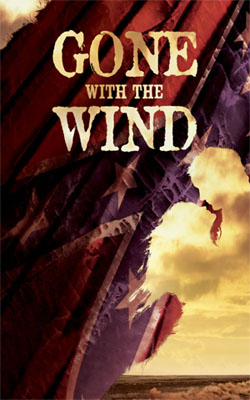
Gone with the Wind is a musical written by Margaret Martin. It was adapted by Trevor Nunn from Margaret Mitchell's 1936 novel of the same name and its 1939 film adaptation.
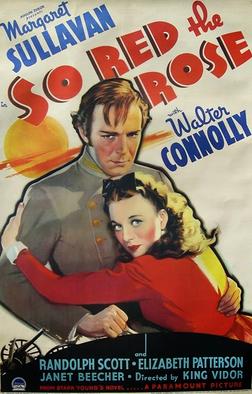
So Red the Rose is a 1935 American drama film directed by King Vidor and starring Margaret Sullavan, Walter Connolly, and Randolph Scott. The Civil War-era romance is based on the 1934 novel of the same name by Stark Young.

Shannen Maria Doherty was an American actress. During her career in film and television, Doherty played a number of notable characters, including Jenny Wilder in Little House on the Prairie (1982–1983); Maggie Malene in Girls Just Want to Have Fun (1985); Kris Witherspoon in Our House (1986–1988); Heather Duke in Heathers (1989); Brenda Walsh in Beverly Hills, 90210 (1990–1994), 90210 (2008–2009), and BH90210 (2019); Rene Mosier in Mallrats (1995); and Prue Halliwell in Charmed (1998–2001).

The Scarlett O'Hara War is a 1980 American made-for-television drama film directed by John Erman. It is based on the 1979 novel Moviola by Garson Kanin. Set in late 1930s Hollywood, it is about the search for the actress to play Scarlett O'Hara in the much anticipated film adaptation of Gone with the Wind (1939). This film premiered as the finale of a three-night TV miniseries on NBC called Moviola: A Hollywood Saga.
Striking Poses is a 1999 American direct-to-video thriller film directed by Gail Harvey and starring Shannen Doherty as a paparazzo photographer who becomes a photography victim herself, of a dangerous stalker. It is rated R for violence and profanity.

American actress Shannen Doherty (1971–2024) appeared in numerous television programs and motion pictures. After her television debut in Father Murphy in 1981, she landed her first major role in the dramatic western television series Little House on the Prairie (1982–1983), and reprised her role in its three television specials. Doherty received two Young Artist Award nominations for playing the oldest Witherspoon sibling Kris in the family drama Our House (1986–1988). She appeared in four films during the 1980s, including the positively-received, animated film The Secret of NIMH (1982) and the cult classic Heathers (1988). Her breakthrough role was as Brenda Walsh in the teen drama Beverly Hills, 90210 (1990–1994), but she was later dropped from the series because of backstage issues and her negative image as a "bad girl". She starred in television films in the early and mid-1990s, and played Rene Mosier in the romantic comedy Mallrats (1995) in an attempt to rebuild her career.
Annie Elizabeth Fitzgerald Stephens was an American landowner, businesswoman, and political activist. She was born to a prominent planting family in Clayton County, Georgia, and grew up on the family plantation Rural Home. The daughter of an Irish immigrant, she was a devout Catholic. Stephens was involved in real estate endeavors in Atlanta and sued the federal government after General William Tecumseh Sherman's Siege of Atlanta, during the American Civil War, damaged some of her properties. Some historians, literary critics, and film critics, including Molly Haskell, consider her to be the inspiration behind the fictional character Scarlett O'Hara, from Stephens' granddaughter Margaret Mitchell's novel, Gone with the Wind.
